Why no endemic flora extinction by wildfires?
Endemic flora as well as fauna has resistance to an incredible extent.
However, during the recent wildfires in Tenerife many were extremely worried. Even, experts said that irrevocable damage to the environment might have been caused by the fires.
Pine Tree Radiata is not indigenous in Tenerife
However today, insider knowledge reveals that the pine trees which didn't resist the fires of the year 2007 were not part of endemic flora of Tenerife. In the middle of last century during an entire decade, 2000 hectares had been planted with the Californian pine called Radiata. This fast growing pine was introduced for timber farming in the Canary Islands... This tree resembles the indigenous Canary pine but doesn't like fire.
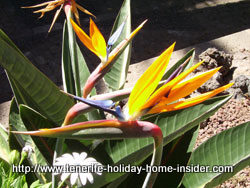
Great varieties of indigenous plants which is the better known expression for endemic flora or, endemic plants occur due to geological and, climatic differences.
Did you know, the Strelitzia in low as well as tall variety is endemic? It's also one of exceptions, which may be grown in domestic gardens.
Natural fire immunity of endemic flora
An unbelievably large amount of indigenous plants have become fire resistant over times that we, often, only may guess.
They created their own defense mechanism against wildfires. They have become resistant. Some have changed over periods of thousands of years or, more.
What is striking is that the smaller a species, be it fauna or flora, the better its chances of survival. Just look at the cockroach or even at the ant.. And what about the most common weeds? The human species must be the big exception despite its size. It is a fact that man has changed and evolved tremendously.
Evolution and, adaptability are like trump cards all nature has been provided with in the cradle of its creation.
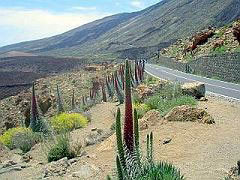
Endemic flowering jewels of the Tenerife National Park
Here is a picture of the strikingly beautiful Echineum Tajinaste. It's the tall plant in the foreground in the photo. Its blooms are only opening
up. Eventually they will become fire red.
The tajinaste is an endemic flora
found mostly at 1400 meters of altitude in the Cañadas del Teide, Tenerife, Canary Islands, Spain.
By the way believe it or not. There are a few Tajinaste plants on Playa Jardin. Find them in volcanic soil outside the former cactus garden near the bridge opposite beach San Felipe Puerto de la Cruz...
The Tajinaste needs environment created by volcanic eruptions.
Geographically, this indigenous plant of the echineum family grows best on Tenerife Island.
Another variety is the blue Tajinaste. In my page Tenerife which you may also find in the Index you may see a whole valley in the Cañadas, lit up with fully flowering Tajinastes. There even is one with white flowers.
Find it in the article that sums up the whole island... Endemic flora and, fauna will have to fight harder when geological conditions are changed.
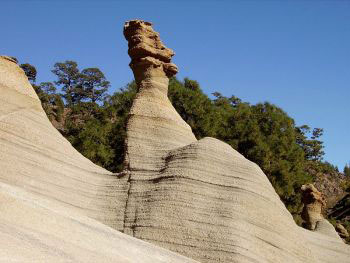
Indigenous Tenerife pine trees
The endemic Canary Island pines are generally strong. They survived many a fire. Did you know that the Canary pine that you may see in the photo by César F.Real Real had once almost been extinct? People had done that out of ignorance. Ignorance has caused havoc to the environment all over our planet Earth. Environment protection has only become an important topic in the last decades.
It's true that wildfires may cause such change indirectly when landslides follow. But a lot of soil needs shifting and, changing.
The Canary pine will therefor not perish. The Canary Island pines are part of endemic flora. Only what is very weak is going to be wiped out for good.
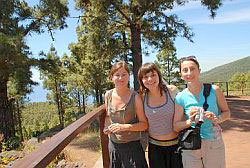
Oh, tourists like the lovely French girls in this photo would not be so happy if the pines were not there.
Here we see them in the Mercedes forest in Tenerife.
That forest was not harmed by fires, recently, by the way.
However, indigenous plants may become extinct when dug up by humans.
Endemic plants may also be destroyed by animals to a certain extent.
Here is an interesting article by the New York Times about indigenous fighting immigrant plants in Tenerife.
They may surely become extinct by chemicals.
But, they may never be destroyed by wildfires such as the wildfires in Tenerife. The fires caused great havoc in some of its forests to Canary pines and, the small flora below but, only destroyed their non indigenous cousins .
Indigenous flora will change or, perish due to longtime deprivation of minerals.
Rarely, some will be wiped out by extremely long times of drought. Why is it seldom?. Seeds may remain in the ground to survive for decades.
Endemic trees or vegetation will also recover after fires when their roots and, bulbs are located deep enough in the ground.
Endemic flora will normally not survive when taken away from its natural habitat. Uprooting and landslides are part of this threat.
Endemic fire immune Queens fern
Perhaps, some Tenerife biologist can tell me if the Queens fern which is depicted beside is also endemic flora of Tenerife. It certainly is indigenous to Quazulu Natal in South Africa. Click to enlarge to see it grow by Canary Island pine trees of Agua Mansa. This fern doesn't only regrow after long dry periods but, also after fires.
I have seen fire resistance of endemic plants over a period of 17 years.
My property border was threatened by wildfires almost at the end of every dry season.
A dry season meant a period of at least 4 months. It could certainly last longer.
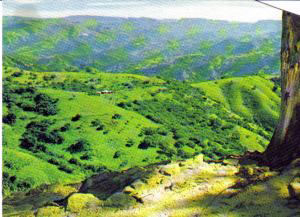
A valley and wilderness reborn again and again
Here is a photo of the valley where I witnessed wildfires at first hand over and, over again.
You may see a fire scorched endemic tree stem on the right. Believe me that its leaves always sprout again.
You may also notice the natural creme colored stones.
That's where scorpions and, other creepy crawlies may hide. Once, I tried to dig up something very small and, indigenous. I hit a hornets' nest. Normally, they don't go underground.
That photo is from a postcard. It shows the nature reserve well after the rains. Flowering only happens at the start.
The few indigenous trees always looked totally scorched after fires.
My wild property in the Valley of the 1000 hills of kzn Quazulu Natal had an area of 5000 square meters. There were no fences in between neighboring grounds. The nature reserve stretched over the slopes of a 6 km long ridge.
However, all was reborn after the first summer rains. Caring for indigenous plants
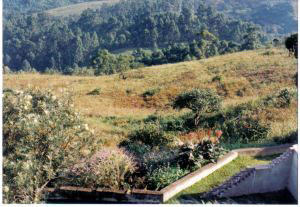
In the picture you may make out a green spot by an equally green tree. All is fed by a tiny natural fountain.
That's were the endemic flora Queen ferns grow by Durban of Natal while the rest of the land turns dry, and yellow. Only, by the end of the dry season the ferns turn brown.
The wildfires with flames as high as the ones seen now in Tenerife were
shaving off all small plants like razor blades, right down to ground level.
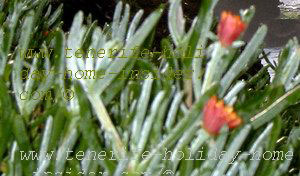
Fire resistant, indigenous Sour fig Ice plants
The only exception were ice plants, a specimen of which with bright red flowers, admire beside. Most ice plants originate from the Namibian San people habitat. They are fast spreading creepers with dermatological healing properties. Ice plants easily climb down slopes. They are not considered invader plants in Quazulu Natal, contrary to Bramble and even Eucalyptus trees. Parts of this endemic flora of the Aizoaceae family were singed, only, as this medicinal herb ground cover is rather fire resistant. The most widely spread specimen was the sour fig variety which stores much liquid and whose fruit I don't remember to have seen ever. I had two different varieties of it on my property, one of which of a daintier quality. The sour fig ground cover was easier to replace and to regrow on sloping ground. This South African flora likes full sun.
By the way, it even tolerated soil in my garden which was rich of lime. On the other hand, it didn't mind salty coastal terrain either, except the extreme salt dunes of Walfis Bay.
Strong, hot winds were always the fires' companions.
Later, when the rains came, everything sprouted back so quickly. This was part of South African natural wonders.
The black ash covered land, lightened by small granite like boulders transformed itself looking like born again. Everything turned into the most magic carpet of spring. Pastel colors with a deep blue or purple in between were its characteristics.
We took the miracle so much for granted.
You know, I always suspected that fires are needed for the rejuvenating of certain plant species.
And, what was the most surprising is that the population of lizards and, other creepy crawlies never became extinct.
They most probably had learned where to hide to survive, long ago.
Here again, small creatures had better chances to find shelter.
The weaker ones might have been killed. That's the rule of nature.
.
How does an island with much indigenous flora protect itself
The University of la Laguna has a an indigenous nursery geared towards preservation and, study of endemic flora for the Canary Islands.
Otherwise, find more information by going back from endemic flora to wildfires in Tenerife of 2007.

Please mind that the comment box below is meant to help others. In case you have a question or want to tell me something, kindly use this contact form.
This site is protected by Copyscape
Transfer wanted
in Europe?

Optica Columbus Best optician Tenerife North Important eye tests Call 922 387072
Insider

Note:
Text and images within this site are not to be copied or traded at any time. This regards online and offline.
Please respect my copyright
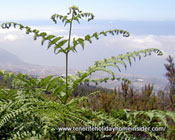


New! Comments
Have your say about what you just read! Leave me a new comment in the box below.